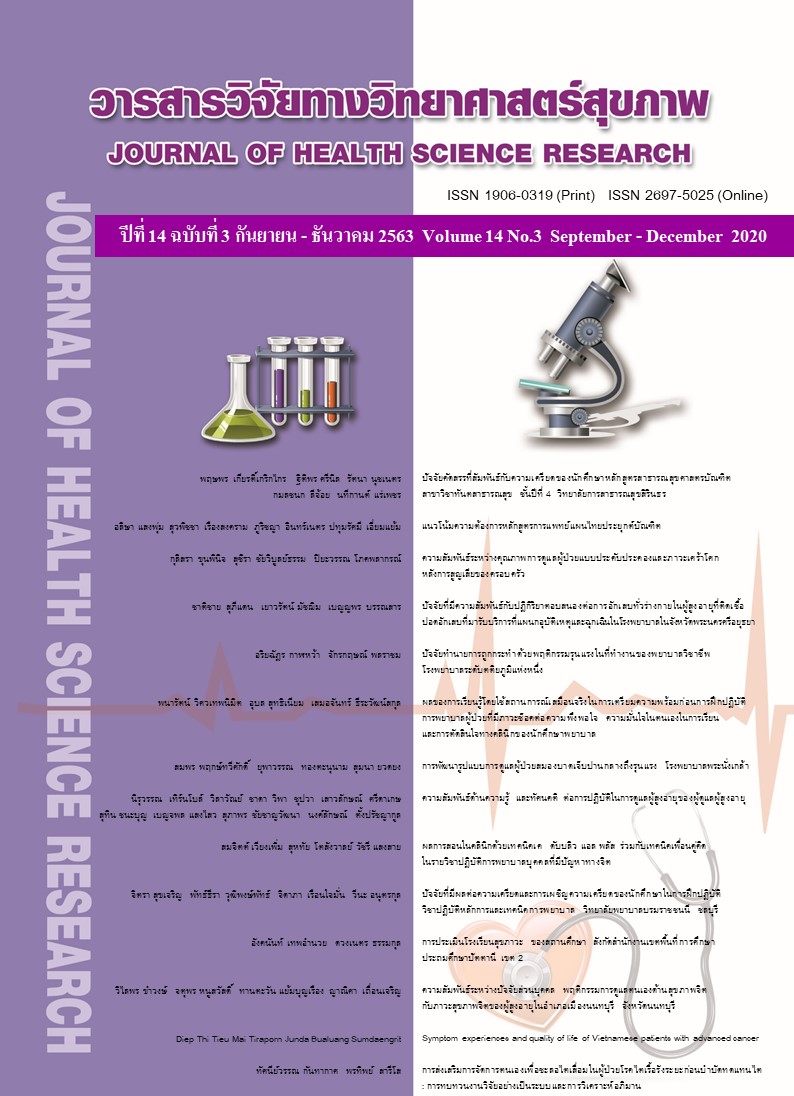ความสัมพันธ์ระหว่างคุณภาพการดูแลผู้ป่วยแบบประคับประคอง และภาวะเศร้าโศกหลังการสูญเสียของครอบครัว
Main Article Content
บทคัดย่อ
บทนำ : ภาวะเศร้าโศกหลังการสูญเสียของครอบครัวมีความสำคัญในการดูแลแบบประคับประคองโดยเฉพาะในระยะท้ายของการเจ็บป่วย โดยช่วยบรรเทาความทุกข์ทรมานของผู้ป่วยและครอบครัวจนกระทั่งผู้ป่วยเสียชีวิต รวมทั้งติดตามดูแลครอบครัวของผู้ป่วยอย่างต่อเนื่อง ทำให้ครอบครัวสามารถเผชิญกับความสูญเสียได้อย่างเหมาะสม
วัตถุประสงค์การวิจัย : เพื่อศึกษาความสัมพันธ์ระหว่างคุณภาพการดูแลผู้ป่วยแบบประคับประคองและภาวะเศร้าโศกหลังการสูญเสียของครอบครัว
วิธีการวิจัย : การวิจัยเชิงบรรยายนี้ ศึกษาครอบครัวผู้สูญเสียจำนวน 110 ราย ที่ได้รับการดูแลแบบประคับประคองก่อนที่ผู้ป่วยจะเสียชีวิต เก็บรวบรวมข้อมูล ณ โรงพยาบาลมหาวิทยาลัยและโรงพยาบาลตติยภูมิ เครื่องมือที่ใช้ ประกอบด้วย แบบสอบถามข้อมูลส่วนบุคคลของครอบครัวผู้ป่วย แบบประเมินคุณภาพการดูแลโดยใช้ความพึงพอใจของครอบครัวต่อการดูแลแบบประคับประคอง (FAMCARE 2) และแบบประเมินภาวะเศร้าโศกที่ผิดปกติ วิเคราะห์ข้อมูลโดยใช้สถิติบรรยายและสัมประสิทธิ์สหสัมพันธ์แบบเพียร์สัน
ผลการวิจัย : พบว่า ความสัมพันธ์ระหว่างคุณภาพการดูแลแบบประคับประคองโดยรวมมีความสัมพันธ์ทางลบในระดับต่ำมากกับภาวะเศร้าโศกอย่างมีนัยสำคัญทางสถิติ (r = -.189, p <.05) และยังพบว่าด้านการจัดการอาการทางกายและความสุขสบาย และด้านการช่วยเหลือสนับสนุนครอบครัว มีความสัมพันธ์ทางลบในระดับต่ำมากกับภาวะเศร้าโศกอย่างมีนัยสำคัญทางสถิติ (r = -.201, p <.05 และ r = -.198, p <.05)
สรุปผล : ผลการวิจัยสามารถนำไปเป็นข้อมูลพื้นฐานในการพัฒนาการจัดการดูแลผู้ป่วยและครอบครัว รวมถึงวางแผนการทำงานของทีมสหสาขาวิชาชีพ โดยเฉพาะด้านการจัดการอาการทางกายและความสุขสบายและการช่วยเหลือสนับสนุนครอบครัว ซึ่งจะส่งผลให้ครอบครัวของผู้ป่วยสามารถปรับตัวกับภาวะเศร้าโศกภายหลังการสูญเสียต่อไป
Downloads
Article Details
บทความที่ได้รับการตีพิมพ์เป็นลิขสิทธิ์ของวิทยาลัยพยาบาลบรมราชชนนี จังหวัดนนทบุรี
ข้อความที่ปรากฏในบทความแต่ละเรื่องในวารสารวิชาการเล่มนี้เป็นความคิดเห็นส่วนตัวของผู้เขียนแต่ละท่านไม่เกี่ยวข้องกับวิทยาลัยพยาบาลบรมราชชนนี จังหวัดนนทบุรี และคณาจารย์ท่านอื่น ในวิทยาลัยฯ แต่อย่างใด ความรับผิดชอบองค์ประกอบทั้งหมดของบทความแต่ละเรื่องเป็นของผู้เขียนแต่ละท่าน หากมีความผิดพลาดใด ๆ ผู้เขียนแต่ละท่านจะรับผิดชอบบทความของตนเองแต่ผู้เดียว
เอกสารอ้างอิง
Callaway MV, Connor SR, Foley KM. World Health Organization public health model: A roadmap for palliative care development. J Pain Symptom Manage. 2018;55(28):6-13.
Wentlandt K, Seccareccia D, Kevork N, Workentin K, Blacker S, Grossman D, et.al. Quality of care and satisfaction with care on palliative care units. J Pain Symptom Manage. 2016;51(2):184-92.
Miyajima K, Fujisawa D, Yoshimura K, Ito M, Nakajima S, Shirahase J, et al. Association between quality of end-of-life care and possible complicated grief among bereaved family members. J Palliat Med. 2014;17(9): 1025-31.
Arizmendi BJ, Connor MF. What is normal in grief?. Aust Crit Care. 2015;28(1):58-62.
Wattanatornnan S. Grief and bereavement: The nursing role. Thai Red Cross Nursing Journal. 2560;10(1):13-21. (in Thai).
Guldin M, Vedsted P, Zachariae R, Olesen F, Jensen A. Complicated grief and need for professional support in family caregivers of cancer patients in palliative care: a longitudinal cohort study. Support care cancer. 2012;20:1679-85.
Stewart AL, Teno J, Patrick DL, Lynn J. The concept of quality of life of dying persons in the context of health care. J Pain Symptom Manage.1999;17(2):93-108.
Isaacs B, Akhtar JA. The set test: a rapid test of mental function in old people. Age Ageing. 1972;1:222-26.
Grant PC, Depner RM, Levy K, Lafever SM, Tenzek KE, Wright ST, et al. Family caregiver perspectives on end-of-life dreams and visions during bereavement. J Palliat Med. 2019;23(1):48-53.
Masterson M, Schuler TM, Kissane DW. Family focused grief therapy: A versatile intervention in palliative care and bereavement. HHS Public Access. 2013; 32(3):117-23.
Aoun S, Bird S, Kristjanson JL, Currow D. Reliability testing of the FAMCARE-2 scale: measuring family career satisfaction with palliative care. J Palliat Med. 2010;24(7):674-81.
Sapinun L. Reliability and validity testing of the FAMCARE-2 scale: Thai Translation. Asia Pac J Oncol Nurs. 2020. (article in press).
Yaiyong O, Lueboonthavatchai P. Depression and grief of the elderly at the Elderly Associate in Nonthaburi Province. Journal of the Psychiatric Association of Thailand. 2554;56(2): 117-28. (in Thai).
Prigerson GH, Maciejewski KP, Reynolds FC, Bierhals JA, Newsom TJ, Fasiczka A, et al. Inventory of Complicated Grief: A scale to measure maladaptive symptoms of loss. Psychiatry Res. 1995;59:65-79.
Hinkle DE, William W, Stephen GJ. Applied Statistics for the Behavior Sciences. 4thed. New York: Houghton Mifflin; 1998.
Kumkwan Y, Chaiyawut P. Preparation of care givers to promote death, dignity, in the end of life patients. Phranakhon Rajabhat Research Journal. 2559;11(2): 125-38. (in Thai).
Brighton JL, Koffman J, Hawkins A, Mcdonald C, Brien S, Robinson V, et al. A systematic review of end-of-life care communication skills training for generalist palliative care providers: research quality and reporting guidance. J Pain Symptom Manage. 2017;54(3):417-25.
Seccareccia D, Wentlandt K, Kevork N, Workentin K, Blacker S, Gagliese L, et al. Communication and quality of care on palliative care units: A qualitative study. J Pain Symptom Manage. 2015;18(9):758-64.
Wuthiphongpat P. Palliative Care according to the Religious beliefs and the Living Will. Veridian E-Journal, Science and Technology Silpakorn University. 2559;3(6): 149-61. (in Thai).
Phengjard J. Nurse’s role in palliative care. Journal of Boromarajonani College of Nursing, Bangkok. 2557;30(1):100-9. (in Thai).
Kübler-Ross E. On Death and Dying. New York: Macmillan; 1969.
Luvira V. Health care for caregivers of patients with terminal illness. Srinagarind Medical Journal. 2556;28(2):266-70. (in Thai).
Yamaguchi T, Maeda I, Hatano Y, Mori M, Shima Y, Tsuneto S,et al. Effects of end-of-life discussions on the mental health of bereaved family members and quality of patient death and care. J Pain Symptom Manage. 2017; 54(1):17-26.


